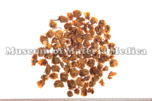Chrysanthemum Flower

|
Market name:菊花(甘) Photo location:Museum of Materia Medica, Inst. of Nat. Med. TMPW No.:15408 |

|
Plant name:Chrysanthemum indicum Photo location:Zhejiang Prov., China Photo date:2009 Photographer:K. Komatsu |
| Synonym | |
| Latin name | Chrysanthemi Flos |
| Botanical source: Family name | Asteraceae (=Compositae) |
| Botanical source: Plant name | - Chrysanthemum indicum Linné (IPNI:193510-1) - Chrysanthemum morifolium Ramatuelle (IPNI:193606-1) |
| Part used | Dried capitulm |
| Empirical criteria for quality selection | Good one is bulky, yellow and has a lot of petals. The newer the better (NI). |
| Constituents | Fatty acids: [C. morifolium]: Acetic acid, Propionic acid Monosaccharides: [C. morifolium (flower)]: Fructose, Glucose, Arabinose, Galactose, Rhamnose, Ribose Oligosaccharides: [C. morifolium (flower)]: Sucrose Monoterpenoids: [C. morifolium]: 2,2,4-Trimethyl-3-cyclohexene-1-carboxylic acid (flower), Borneol, Bornyl acetate, Camphor, α-Thujione Flavones & Flavonols: [C. morifolium (flower)]: Apigeninglucoside Other aromatic derivatives: [C. morifolium]: Benzoic acid, Benzaldehyde, Anisaldehyde Simple nitrogen containing compounds: [C. morifolium]: Adenine, Choline (flower) Unknown: [C. morifolium]: Acacetin-7-rhamnoglucoside (flower), Stachydrine, Chrysanthenone |
| Pharmacological effects | Weak hypohypothermic (malfunction of the circulatory system in overdose), enhancement of capillary-resistant, antibacterial (Chrysanthemum Flower produced in Hangzhou Prov.: various cutaneous fungus) |
| Indications | As antifebrile, antidote, painkiller and anti-inflammatory, it is applied to treat common cold, fever, chill, headache, eye swelling, dizzing and swollen carbuncle. It is also used for arteriosclerosis and hypercholesteremia. It is taken as medicinal tea. |
| Diseases | Fever, Headache, Cough, Sore throat, Red eye, Bleary eyes, Decreaced vision, Vertigo, Stagger |
| Formulas | kogikujiogan , jijinmeimokuto , seijokentsuto , senkanmeimokuto , chotosan |
| Meridian tropism | Lung, Liver |
| Property | Slightly cold |
| Flavor | Sweet, Bitter |
| Classification in "Shen-non Ben-cao Jing" | Superior |
| TCM: Classification | Diaphoretics |
| TCM: Medicinal effects | To disperse wind and clear heat, pacify the liver to improve vision, clear heat and remove toxin. Used for common cold caused by wind-heat, headache and dizziness, red painful swelling eyes, blurry vision, sore, abscess, swelling and toxin. |
| Remarks | Listed in the Japanese Pharmacopoeia 18th ed. |
| References | NI: N. Isshiki, Methods of Quality Evaluation and Preparation of Wakan-yaku, Tohodo Shoten, Tokyo, 1987. |
DNA sequences of medicinal plants
| Gene Region | |||||||||||||||||||
| Nuclear | Chloroplast | Mitochondria | |||||||||||||||||
| Botanical source: Plant name | 5Ss | 18S | ITS1 | 5.8S | ITS2 | 26S | others | trnH-psbA | matK | trnK | trnK-rps16 | trnT-L | trnL | trnL-F | rbcL | rpoC1 | ndhF | others | |
|
|
|||||||||||||||||||
|
|
AB234678 AB234679 AB234680 AB234681 AB234682 AB234683 AB234688 AB234694 AB234695 AB234697 AB234801 AB234802 AB234803 AB234804 AB234805 AB234806 AB234811 AB234817 AB234818 AB234820 AB234842 AB234843 AB234844 AB234845 AB234846 AB234847 AB234852 AB234858 AB234859 AB234861 EF091639 AB234637 AB234638 AB234639 AB234640 AB234641 AB234642 AB234647 AB234653 AB234654 AB234656 |
||||||||||||||||||
